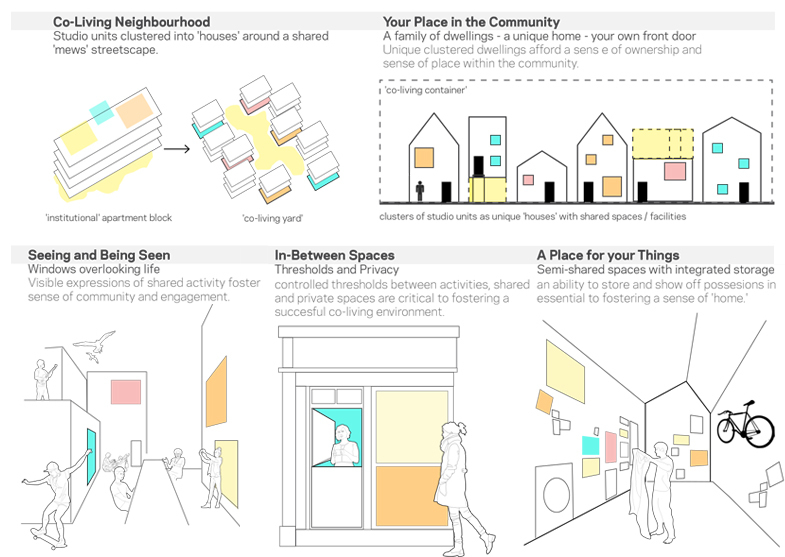
Nicholas Taggart of 7N reflects on the emergence of Co-Living communities following a recent feasibility study for a project in London.
Co-Living
The place of the flat-share is cemented in popular culture, contributing more than its fair share to the sit-com and film canon: Friends, Spaced, New Girl,The Young Ones, Shallow Grave et al. However, shared living environments are becoming increasing more common arrangement for a growing demographic of older ‘sharers,’ particularly in large cities. 7N recently completed a feasibility looking at how the built form of a co-living environment could foster a genuine sense of communal living whilst maintaining thresholds for privacy and individual space.
Between 2009 and 2014, the number of flatsharers aged between 35 and 44 rose by 186%, according to Spareroom, the UK’s biggest flatshare website, while the number of sharers aged 45 to 54 went up by 300%.
House prices may have dipped in certain parts of the country, for the first time since the financial crisis , but it’s probably premature to claim that the ‘property owning democracy’ is dead. However given that a quarter of households in the UK are predicted to rent privately in the UK by 2021 and rates of home ownership and social renting continue to fall, new models of shared housing development could form a growing part of the future for housing in the UK.
“Between 2009 and 2014, the number of flatsharers aged between 35 and 44 rose by 186%”
Shared housing itself may be nothing new, but a number of purpose-built ‘co-living’ communities in cities like Manchester and London are evidence of growing sector of development specifically designed for shared living. These schemes may typically offer a rented room, with shared facilities such as a communal kitchen, dining hall or games room, and include a number of services such as laundry facilities, wifi, utilities, fitness and club memberships for a single monthly fee.
Initial developments in the UK have typically targeted young-professionals, adopting many of the millennial stylistic marketing imagery seen across the sharing economy. These take their cues from the far larger and more established market in the US, where companies such as WeLive offer a rented living environment on a daily, weekly or monthly basis similar to the co-working model of spaces like WeWork or SecondHome.
These recent high-density co-living developments point to genuine necessity for quality living space within urban environments where individual private renting and ownership are now economically out of reach for a growing number people. But there remains an open question as to whether such developments can provide a more sustainable form of housing in the long term, beyond ‘student-housing for adults.’
Co-habitation within groups can have many benefits; with the potential for a greater generosity to shared spaces than could ordinarily be provided within individual housing models and opportunities to nurture the basic human for community.
Co-housing also offers particular opportunities for people at many stages of life for whom a residential neighbourhood and community is of benefit; including newcomers to a city, those whose living circumstances have changed as well as the elderly.
“There remains an open question as to whether such developments can provide a more sustainable form of housing in the long term, beyond ‘student-housing for adults.’ ”
As an example, The Older Womens Co-Housing Group’s ‘New Ground’ development in Barnet has created a community for 20 single women, where each member has their own self-contained flat and shares common room, guest suite, garden and laundry. All designed to encourage a socially fluid lifestyle where everyone has the opportunity to share in the life of the group and contribute in whatever way they can: sharing maintenance and gardening tasks, cooking and eating together.
A number of ‘early-adopter’ co-housing schemes are also being progressed in Scotland, such as those by both Pennington Cohousing in Glasgow, and the Vivarium Trust in Fife, which have shown that there is a demand locally for alternative models of housing.
Such environments present an opportunity for innovation, development and adaption of housing typologies to suit shared living. Last year’s British Pavilion at the Venice Biennale ‘Home Economics’ explored themes around how domestic space might be shared or adapted for changing durations of stay and transitory living and shared some affinity with the enduring, careful, studies of shared places and spaces found in Christopher Alexander’s ‘A Pattern Language’ from 1977.
“Last year’s British Pavilion at the Venice Biennale ‘Home Economics’ explored themes around shared domestic space and shared some affinity with the enduring, careful, studies of shared places and spaces found in Christopher Alexander’s ‘A Pattern Language’ from 1977”
There is of course a risk, that ‘co-living’ becomes appropriated as simply another marketing approach, targeting lifestyle affectations without addressing genuine housing need. More significantly, in light of new tenure models, an open minded but rigorous approach is required by planning authorities and local government to ensure that housing space and quality standards continue to be developed at pace with the property market.
Whilst land value pressures in most Scottish cities may not yet have hit the peaks seen elsewhere in the UK– the Scottish Government’s commitment to deliver 50,000 new affordable homes in Scotland by 2021 will require innovative approaches to delivery, housing design and creative responses to the very wide range of housing needs that now exist in our communities. Co-living will never be more than a minor part of that picture but offers an important option for key groups of people who may otherwise be marginalised and isolated.

